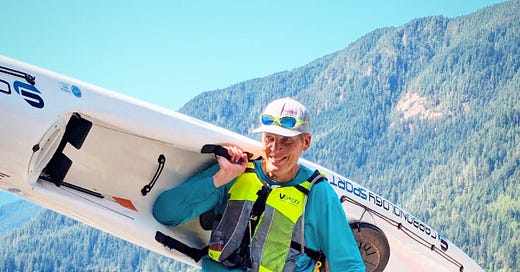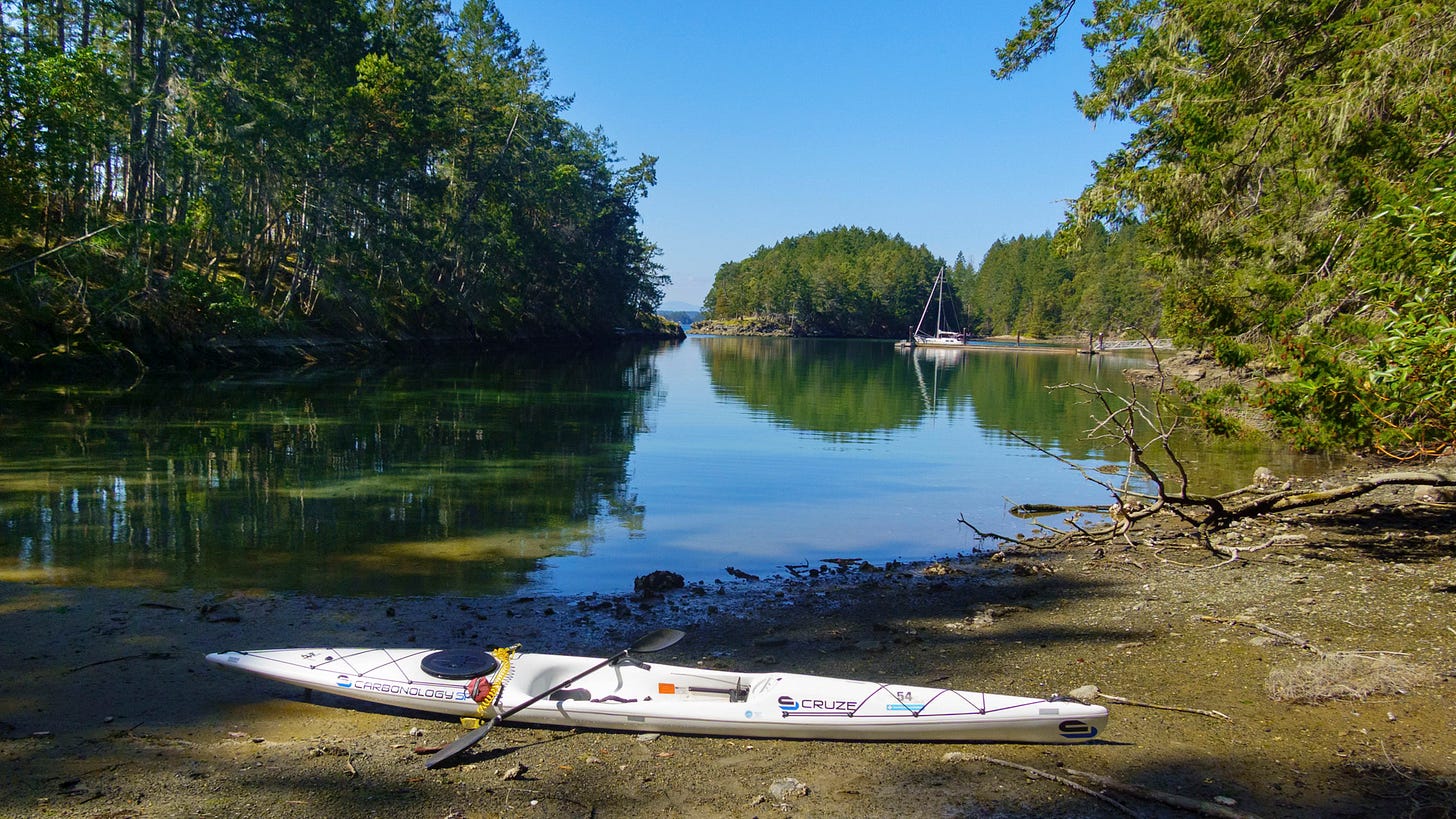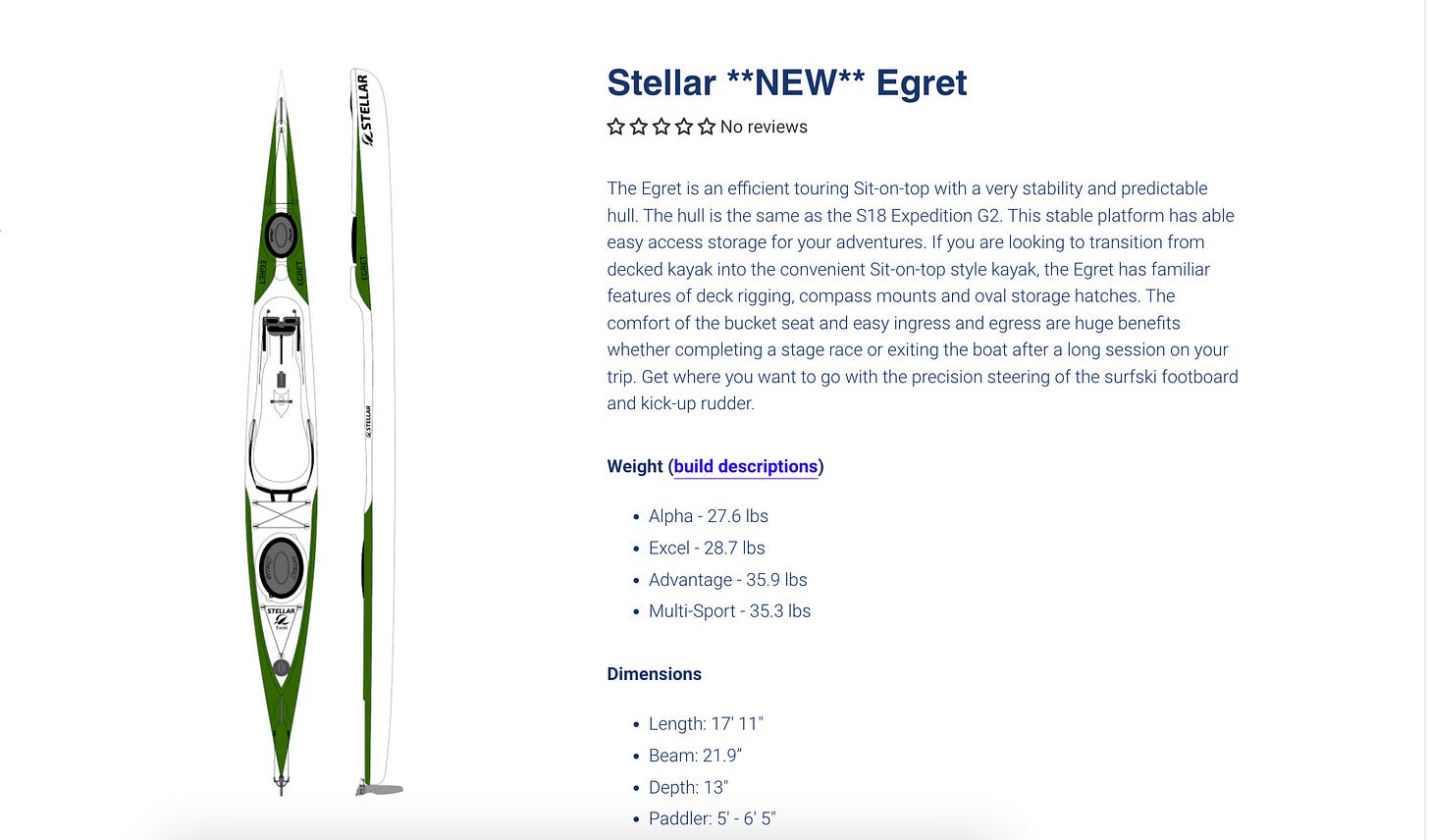Like many wanting to tour the Salish Sea, I started with sea kayak training through local shops and clubs. I bought a few kayaks, then added on whitewater. surf kayaking and rolling, (and more boats) to paddle in coastal conditions and the tidal rapids at Deception Pass.
One day in 2003 while surfing the Washington coast in a surf kayak, I got flipped backwards and upside down. Despite having a good roll, I panicked, fowled my roll and tried to wet-exit, but couldn’t.
My neoprene skirt was on super tight to prevent implosion from waves and despite extensive training to remove skirts, I began to take in saltwater. It wasn’t good. At one point I got it off and went to shore to recover.
From that time on, while I continued to kayak with a spray skirt and improved my wet-exits, rolls and panic control, I began to look for other ways to paddle without being ‘in’ a boat.
The Discovery
A few years later, I was tug surfing near Seattle and paddler Don Kiesling joined in for a session on his surf ski. I had tried for years to surf the tug wakes with my sea kayaks but couldn’t get a long ride due to the curved rocker in the hull which requires a stern rudder stroke to stay straight for most surfing. This technique creates a lot of drag.
Don dropped in on his ski and rode the wave nearly a half mile to the West Point Lighthouse.
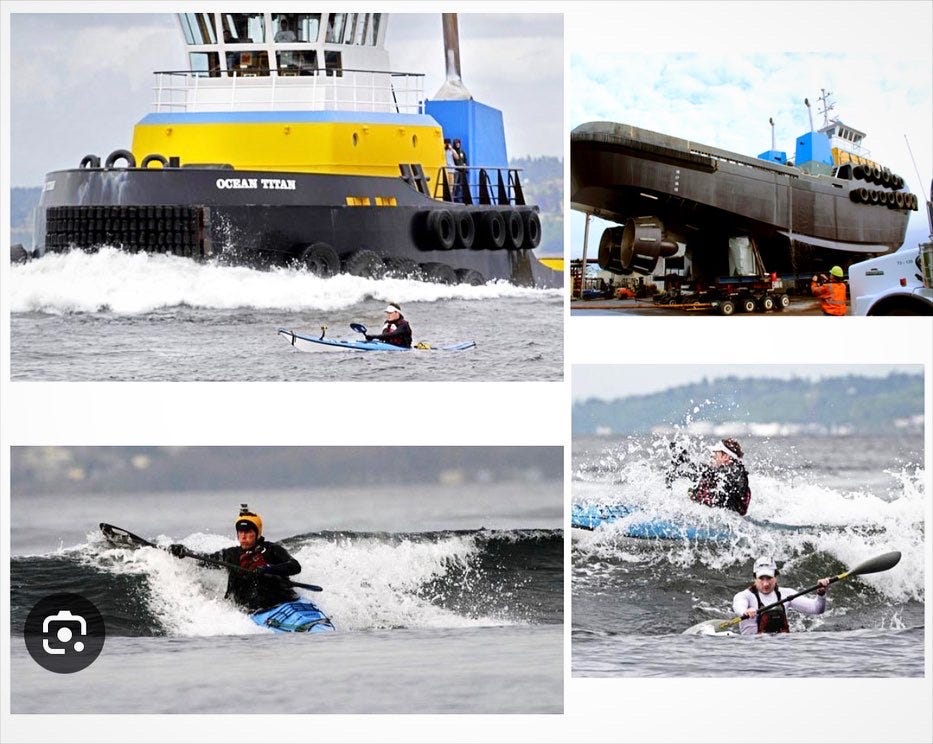
Note: The above sequence of photos were from when the Seattle Times featured us surfing tug wakes on Shilshole Bay in 2012. The top left image was on the front page! Photographer Mark Harrison came out a few times in a boat to get shots of us surfing. Eric Lacitis wrote the piece. Read it here.
Around the same time, I saw Don paddle upwind in about 30 knots without any issue. On my sea kayak, I definitely was slower as Don disappeared out of view.
I began to wonder if surf skis could be used for kayak touring and regular paddling versus just being seen as a nimble elite boat. But somewhere in there, I got distracted for a decade or so by the then new sport of paddle boarding which I entered full-on as a coach and author of a book.
A Change in Direction
After 18 years of doing sup full-time, my legs began to take a toll probably due to blood clots in 2016 and later varicose veins which restrict blood flow. Leg cramps after big paddling days also developed. Not enough hydration magnesium, massages, yoga and CBDs were enough.
I started to look at sitting down again and that’s when surf skis popped back into my view. Around this time I was doing a lot of local races on sup including two Seventy48 attempts. Skis were always part of those events. I couldn’t help notice skis flying by me with a lot less effort than I was putting out on my sup.
By then skis had gone from being super unstable for experienced paddlers to having more stable hull options for all levels of paddlers.
Like many, my first ski was found on CraigsList and was cheap and tippy. But I got it figured out over time, enough to have some fun. Things changed when I showed up to a Sound Rowers race and a few commented on my long legs (I’m 6’-4”) being more out of vs inside the boat. Leg drive wasn’t possible.
My First Touring Surf Ski
Through Jim Marsh in Bellingham, I found a stable ski that I fit in better called the Carbonology Cruze. This version of the Cruze is their touring model which has a big stern hatch like a sea kayak, a day hatch in the bow and ample leg room.
The Cruze is a ‘beginner ski’ at 18’ x 22”. It was a perfect fit for the waters I like to paddle which include surf, tidal rapids, coastal, downwind waves and boat wakes.
Being a beginner ski, it’s not as fast as the more narrow efficient skis for racing but that’s not my focus any more and I rather surf and prefer stability in rough seas. And its way faster than any sea kayak I had owned.
It’s foot pedals for controlling the rudder make surfing much easier not requiring a kayak style stern rudder stroke. When I apply kayak style edging with a ruddered turn, I can turn the ski on a dime.
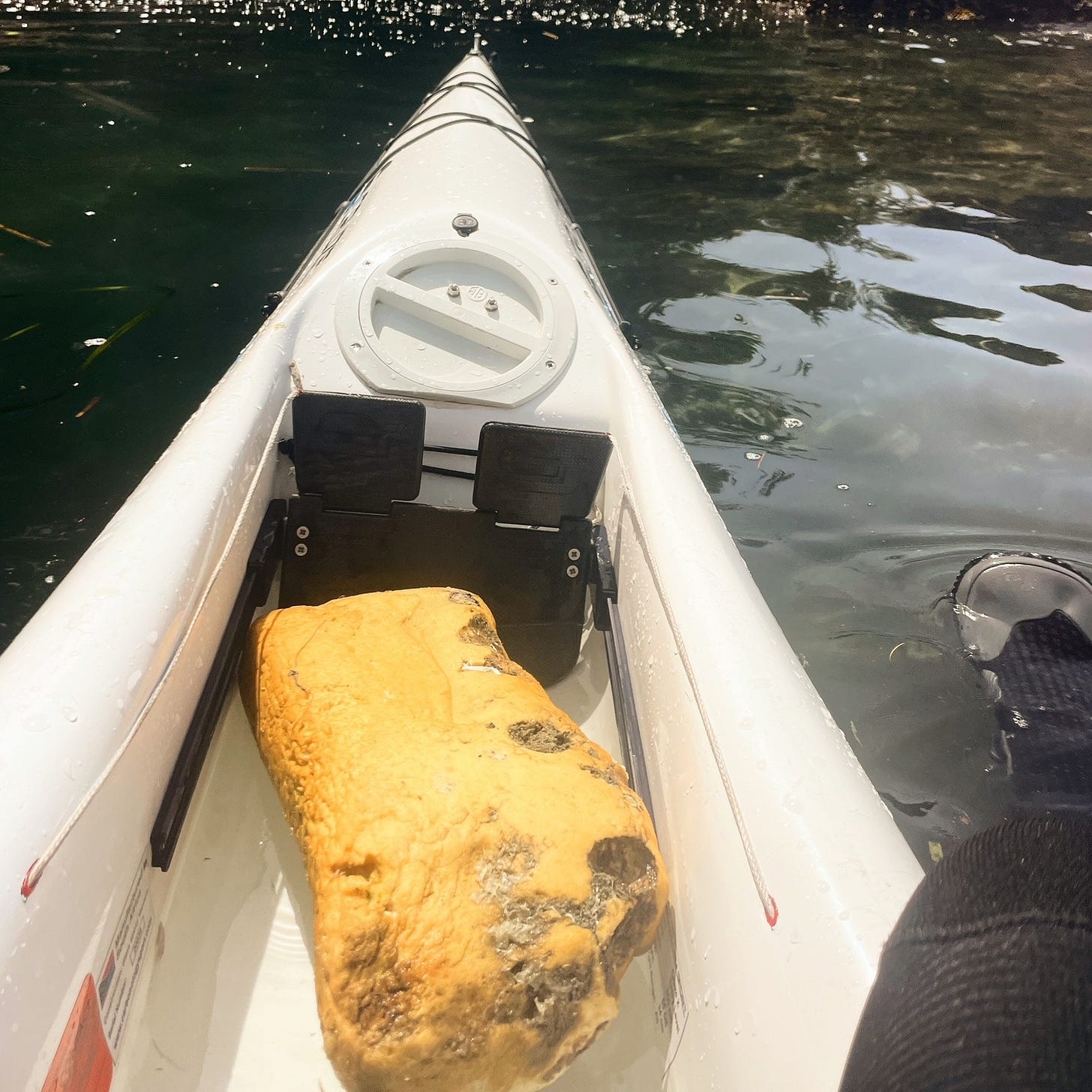
Book Update
When I signed the contract to update the 4th edition of my book “Paddling the Salish Sea 80 Trips” the Cruze was my choice of craft.
Unlike sea kayaks, carbon and glass touring skis are about 35 lbs. Some have lighter layups. Even less weight with no hatches. I have an Epic V8 with no hatches in the Ultra option at 24 lbs.
As a solo paddler the weight was a benefit while updating the book when hauling out of long steep boat ramps, across a few mudflats, a portage or two and lots of car topping between trips.
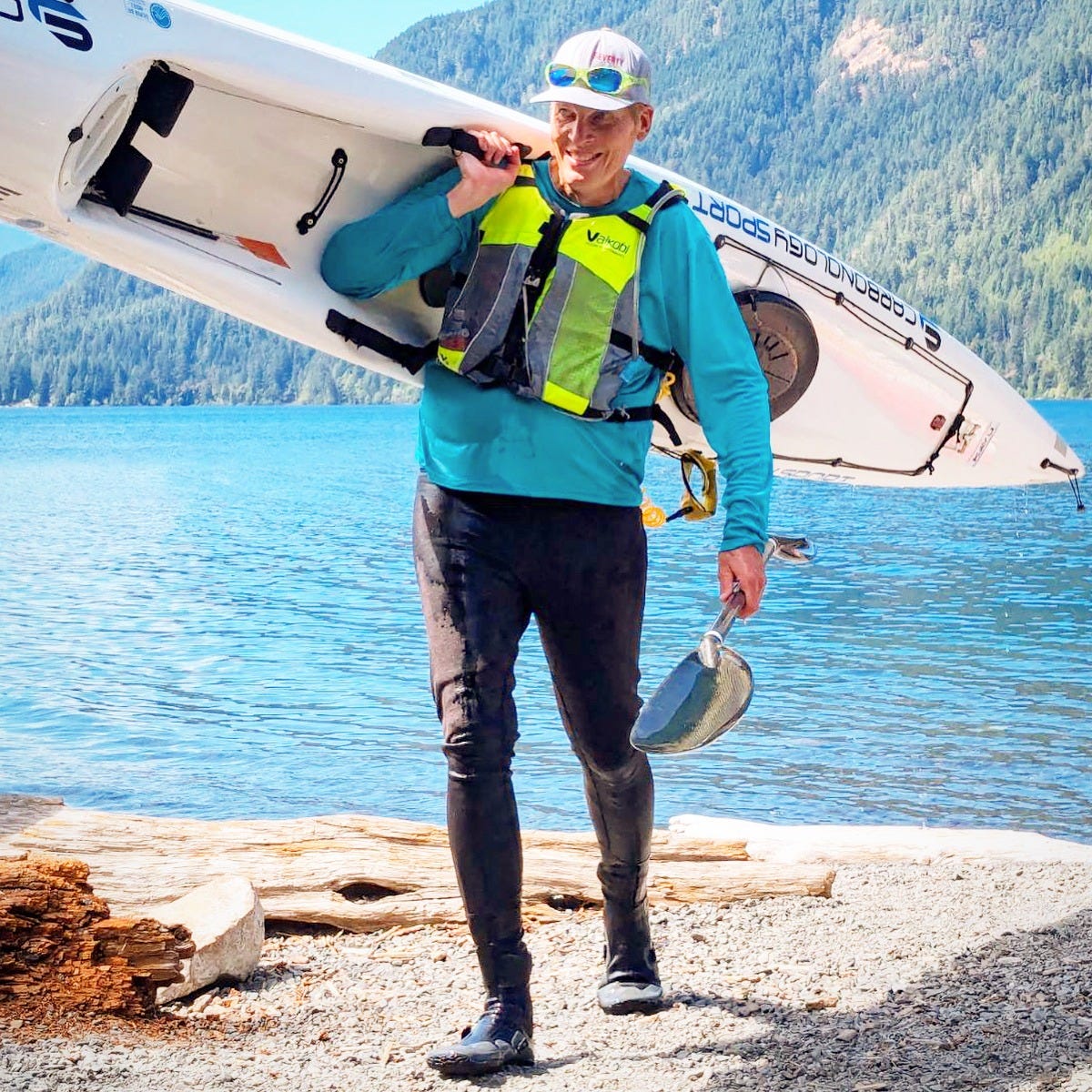
Note: I soloed most of my book trips due to the tight deadline I was on which was difficult to schedule paddle partners or to go with clubs. I solo most of the time and take precautions to stay off the news.
I carried my heavy Canon camera with a telephoto lens in the stern hatch as well as other gear. And my VHF radio, gloves, hat and first-aid / repair kit in the front day hatch. On longer trips, I stashed a backup 1.5 litre water bladder in the day hatch.
Hydration: I use Vaikobi PFDs which have a hydration bladder sleeve in the rear. The pfd comes in hi-vis colors for visibility and has pockets for storing things. Unlike many bulky kayak pfds, the Vaikobi’s are flat fronted which make it easier to remount.
The Cruze touring model has an option for a kick up rudder which I recommend for shallow water, tide pooling, kelp beds and beach launches.
The Stability Myth - That Looks Tippy:
I spend a lot of time trying to convince folks that touring surf skis are stable for all levels of paddlers. But the sleek needle shape of the boats lead folks thinking these are tippy.
While updating my book with the Cruze, I was able to throw my legs over the side while pulling from the stern hatch my Canon SLR camera with a 200mm telephoto lens, then shoot pics. I often did this in choppy waters.
I’ve only capsized a few times in the boat, each in big water like 5 foot or larger surf trying to make surf kayak style bottom turns.
I teach my surf ski lessons in the Cruze as beginners need that stable feeling their first day. And the cockpit is roomy for a lot of different body types.
Stable skis for surf ski beginners start at 20” wide. Always try before you buy.
Other Touring Surf Skis
Other stable and fast touring skis like the Epic Kayaks Tourer and Egret from Stellar Kayaks have full bow and stern hatches as well as an option for a kick up stern rudder (also called a steel over stern rudder). These boats are about 18’ and 20-22” wide.
More Details about Touring Surf Skis
You can use a regular kayak paddle with a surf ski or purchase a ‘wing’ which is a surf ski paddle. Best to try each if you can.
I recommend a lesson before you start investing in boats and gear. My 1-1 and 2 person lessons will save you a lot of money and time. I provide all gear including boats and toasty wetsuits in the off seasons. Give me a holler to schedule a lesson.
Most surf ski folks use a leg leash, but I attach a sup coiled leash to my pfd side straps and to a secure spot on the back deck. I find it safer and easier for remounts.
Look into accessories such as the Epic seat pad.
For under boat rudders, get the DK Surf Rudder from Don Kiesling in Hood River. He’s at surfski@gmail.com This ruddder will provide more stability and speed.
Check out my blog on my site for what to pack in your ski, PFD contents, etc..
Try before you buy any ski. For beginners, aim for a stable beginning ski starting at 20” wide or wider. Avoid the super cheap old looking ski on CL or Marketplace.
Surf ski info for big paddlers (like me)
Where to Purchase Touring Surf Skis
In the Pacific Northwest, your can find Carbonology and Stellar Kayaks at Ocean Flight in Stevenson, WA. Ask for Bob at Ocean Flight.
If you order the touring version of the Carbonology Cruze, make sure to mention that model in hybrid and for the steel over stern rudder. It may have to be shipped to Bob from the manufacturer in South Africa. He has non-hatched models in stock.
Epic Tourer
Sound Bikes and Kayaks in Port Angeles
Resources:
Get my book Paddling the Salish Sea to find out where and how to paddle and camp overnight from Olympia to Vancouver, the Gulf Islands, Vancouver Island and the Olympic Peninsula.
I provide custom paddling coaching:
Through my business Salmon Bay Paddle I offer 1-1 and 2 person personalized paddling lessons for sups and surf skis in the Seattle area and beyond for all skill levels.
Whether starting as a total beginner or as an advanced paddler seeking to refine your skills I can help you reach your goals whether it be touring, learning about tides and currents or trip planning, paddling safely in Deception Pass or surfing freighter waves in Seattle.
Contact me to chat. / Follow me on IG: @salmonbaypaddle
Related Posts:
Using Tidal Currents to your Advantage
Nighttime Paddling: Essential Tips for After-Dark Adventures
Capturing the Salish Sea: My Kayak Camera Setup for Epic Paddling Adventures


